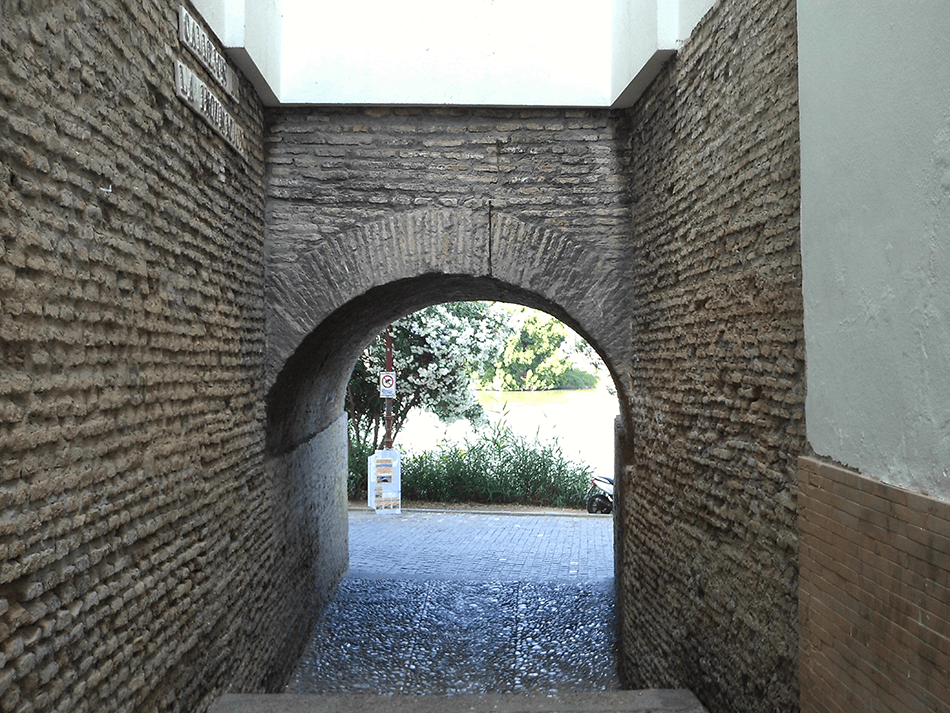
Discover the stories and tales surrounding the neighbourhood of Triana, where the seed of Seville’s popular character is focused. The area is an ideal setting for the origin and development of many legends and myths surrounding the most characteristic places of the neighbourhood, located on the other side of the Guadalquivir River.
The Plaza del Altozano, on the shores of the Guadalquivir River
The Castle of San Jorge, a Visigoth fortification, was and continues to be a protagonist in the dark legends of Seville as it was the headquarters of the Holy Inquisition starting in the year 1481 and was the principal reason for amplifying the Plaza del Altozano. A few years later, the aforementioned plaza, having been amplified after the demolition of the Castle of San Jorge, was the location chosen to build what is now the Triana Market. It is currently possible to visit the ruins, which are conserved today, of what was once the leading location of the inquisition and discover the mysteries and details that surround the dark history of the building.
Triana Market: Castle of San Jorge
Also known was the Castle of the Inquisition, given that the Holy Office occupied it during various centuries, the Castle of San Jorge was set up as a strategic location to store cereal, grape vines and olive crops. As the years went on, the castle became part of one of the most important city suburbs in the area, the neighbourhood of Triana, where the population began to grow considerably and where it was possible to dominate one of the shores of the Guadalquivir river, making it a main water source. Its geographic location also paved a more direct path to the city of Huelva, which at the time, was the leading commercial port.
Those who were found guilty of heresy were sent to the Castle of San Jorge and rumour has it, that they may not have committed any crimes but had simply been pointed out by neighbours because of resentment or petty jealousy. Currently, there are still remains of what was once either the home of the caretaker or notary, horse stables, kitchen, wine cellar, the house of the first inquisitor or the family of the inquisitor. If you wish to visit these ruins, you will need to go through the Triana Market to see them but it is possible.
Activity at the Castle of San Jorge was dormant from the years 1481 to 1785. Its interior housed 26 jail cells, which were considered in the 17th century to be “caverns of horror” by the Holy Office itself. The Castle of San Jorge had the structural defect of suffering from relatively frequent flooding, as it was located next to the river. When the tide rose, it completely flooded the interior of the castle, which paved the way for the spread of a series of minor epidemics, in that area specifically, as well as throughout the city.
Nowadays, it is possible to enter and visit the Castle of San Jorge Museum, popularly known as the Museum of the Inquisition, which displays throughout various exposition halls, the conserved remains of the era in question. The Sensory Room, for example, explains various actions that were carried out by the Holy Inquisition, such as the value judgment, the abuse of power or the powerlessness of the victims. The Barbacana Hall, with an interpretive hallway, displays a series of models and panels that narrate the situations that took place there over the years and a series of remains, such as the jail walls or the chapel, are there to finish off the visit and reflect.
Inquisition Alley
In the 15th century, these 35 metres were the last metres of life for a large number of people arrested for heresy and condemned by the Court of the Inquisition. The Castle of San Jorge was built by the Visigoths, who created a fortification next to the river to defend the city of Spalis, a Visigoth name that was given to the city at the time. As the 15th century advanced, the castle began to lose its relevance and become the leading headquarters for the Inquisition. By way of this alley, prisoners were brought in or rather they were taken to jail to be judged, or condemned to be hanged for heresy and traitors of the Catholic religion.
The Court of the inquisition remained active until the year 1820, when King Ferdinand VII decided to abolish it. This date also coincides with the demolition of the Castle of San Jorge, of which today only remains the narrow alleyway. Currently, legend says that in the silence and tranquillity of the night, it is possible to hear the chains being dragged along the floor and the cries of those who were imprisoned.
These are not the only remnants left from the inquisition. The Cruz de Las Siete Cabezas (The Cross of Seven Heads), also known as the Cross of the Inquisition, was placed in the San Francisco Plaza in remembrance of the last declaration of faith held by the Holy Inquisition. Currently, it is located in Plaza Nueva, where the audience stood in the old Convent Casa Grande de San Francisco.
